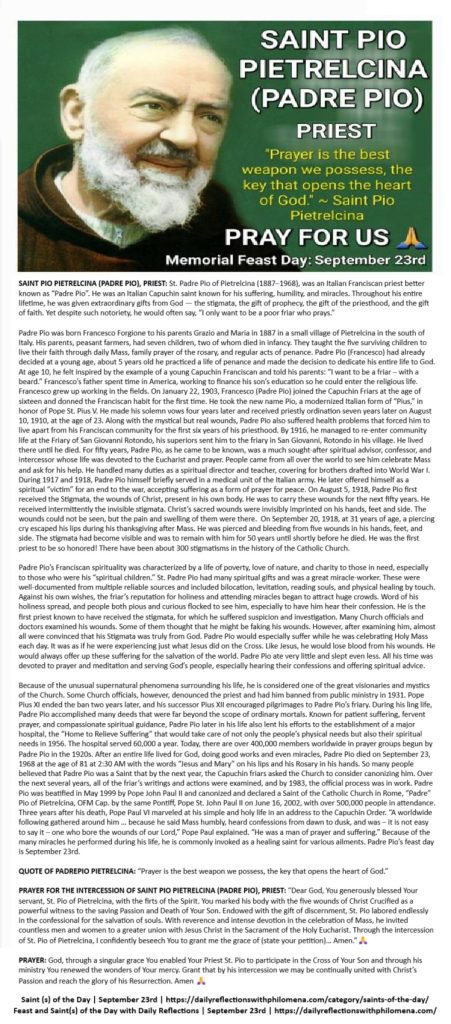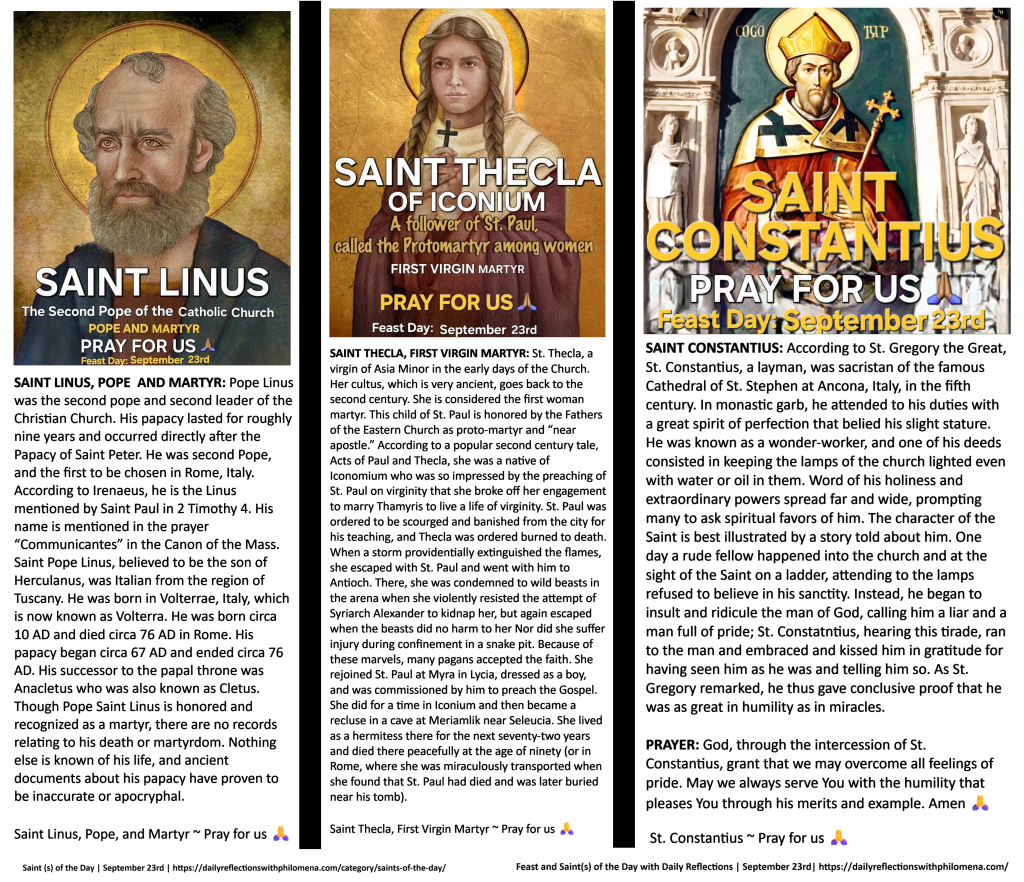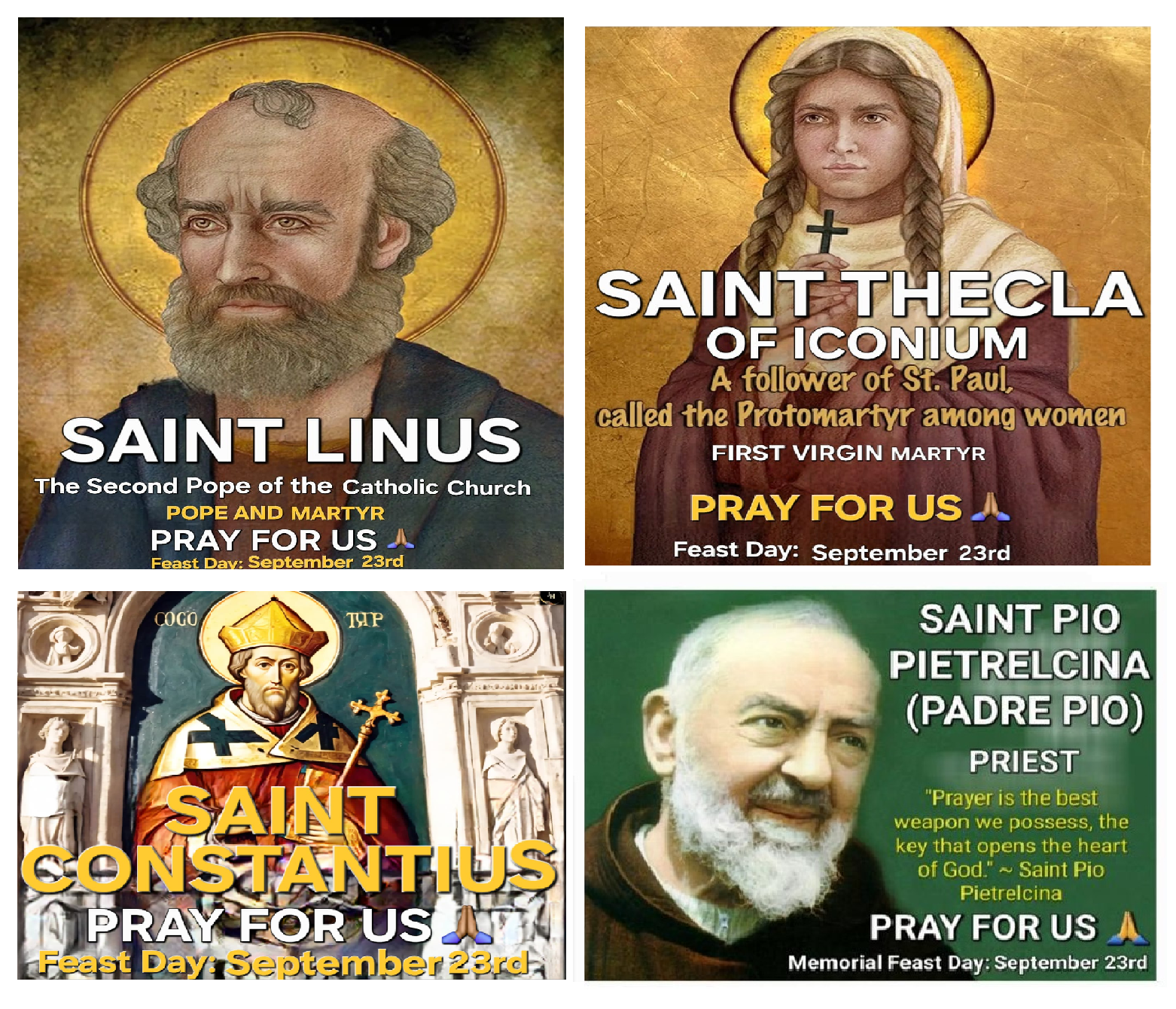

MEMORIAL OF SAINT PIO OF PIETRELCINA (PADRE PIO), PRIEST; SAINT LINUS, POPE AND MARTYR; SAINT THECLA, FIRST VIRGIN MARTYR AND SAINT CONSTANTIUS: Today, we celebrate the Memorial of Saint Pio of Pietrelcina (Padre Pio), Priest; Saint Linus Pope and martyr; Saint Thecla, First Virgin Martyr and Saint Constantius Through the intercession of our Blessed Mother Mary and the Saints on this feast day, we humbly pray for the sick and dying, especially those who are mentally and physically ill and those suffering from cancers and other terminal diseases. We pray for the souls in Purgatory and the repose of the souls of the faithful departed. We pray for all widows and widowers. We pray for the poor and needy, for peace, love, and unity in our marriages, our families, and our world. And we continue to pray for our Holy Father, the Bishops, the Clergy, for vocations to the priesthood and religious life, for the Church, for persecuted christians, for the conversion of sinners, and Christians all over the world…. Amen🙏
SAINT PIO PIETRELCINA (PADRE PIO), PRIEST: St. Padre Pio of Pietrelcina (1887–1968), was an Italian Franciscan priest better known as “Padre Pio”. He was an Italian Capuchin saint known for his suffering, humility, and miracles. Throughout his entire lifetime, he was given extraordinary gifts from God — the stigmata, the gift of prophecy, the gift of the priesthood, and the gift of faith. Yet despite such notoriety, he would often say, “I only want to be a poor friar who prays.”
Padre Pio was born Francesco Forgione to his parents Grazio and Maria in 1887 in a small village of Pietrelcina in the south of Italy. His parents, peasant farmers, had seven children, two of whom died in infancy. They taught the five surviving children to live their faith through daily Mass, family prayer of the rosary, and regular acts of penance. Padre Pio (Francesco) had already decided at a young age, about 5 years old he practiced a life of penance and made the decision to dedicate his entire life to God. At age 10, he felt inspired by the example of a young Capuchin Franciscan and told his parents: “I want to be a friar – with a beard.” Francesco’s father spent time in America, working to finance his son’s education so he could enter the religious life. Francesco grew up working in the fields. On January 22, 1903, Francesco (Padre Pio) joined the Capuchin Friars at the age of sixteen and donned the Franciscan habit for the first time. He took the new name Pio, a modernized Italian form of “Pius,” in honor of Pope St. Pius V. He made his solemn vows four years later and received priestly ordination seven years later on August 10, 1910, at the age of 23. Along with the mystical but real wounds, Padre Pio also suffered health problems that forced him to live apart from his Franciscan community for the first six years of his priesthood. By 1916, he managed to re-enter community life at the Friary of San Giovanni Rotondo, his superiors sent him to the friary in San Giovanni, Rotondo in his village. He lived there until he died. For fifty years, Padre Pio, as he came to be known, was a much sought-after spiritual advisor, confessor, and intercessor whose life was devoted to the Eucharist and prayer. People came from all over the world to see him celebrate Mass and ask for his help. He handled many duties as a spiritual director and teacher, covering for brothers drafted into World War I. During 1917 and 1918, Padre Pio himself briefly served in a medical unit of the Italian army. He later offered himself as a spiritual “victim” for an end to the war, accepting suffering as a form of prayer for peace. On August 5, 1918, Padre Pio first received the Stigmata, the wounds of Christ, present in his own body. He was to carry these wounds for the next fifty years. He received intermittently the invisible stigmata. Christ’s sacred wounds were invisibly imprinted on his hands, feet and side. The wounds could not be seen, but the pain and swelling of them were there. On September 20, 1918, at 31 years of age, a piercing cry escaped his lips during his thanksgiving after Mass. He was pierced and bleeding from five wounds in his hands, feet, and side. The stigmata had become visible and was to remain with him for 50 years until shortly before he died. He was the first priest to be so honored! There have been about 300 stigmatisms in the history of the Catholic Church.
Padre Pio’s Franciscan spirituality was characterized by a life of poverty, love of nature, and charity to those in need, especially to those who were his “spiritual children.” St. Padre Pio had many spiritual gifts and was a great miracle-worker. These were well-documented from multiple reliable sources and included bilocation, levitation, reading souls, and physical healing by touch. Against his own wishes, the friar’s reputation for holiness and attending miracles began to attract huge crowds. Word of his holiness spread, and people both pious and curious flocked to see him, especially to have him hear their confession. He is the first priest known to have received the stigmata, for which he suffered suspicion and investigation. Many Church officials and doctors examined his wounds. Some of them thought that he might be faking his wounds. However, after examining him, almost all were convinced that his Stigmata was truly from God. Padre Pio would especially suffer while he was celebrating Holy Mass each day. It was as if he were experiencing just what Jesus did on the Cross. Like Jesus, he would lose blood from his wounds. He would always offer up these suffering for the salvation of the world. Padre Pio ate very little and slept even less. All his time was devoted to prayer and meditation and serving God’s people, especially hearing their confessions and offering spiritual advice.
Because of the unusual supernatural phenomena surrounding his life, he is considered one of the great visionaries and mystics of the Church. Some Church officials, however, denounced the priest and had him banned from public ministry in 1931. Pope Pius XI ended the ban two years later, and his successor Pius XII encouraged pilgrimages to Padre Pio’s friary. During his ling life, Padre Pio accomplished many deeds that were far beyond the scope of ordinary mortals. Known for patient suffering, fervent prayer, and compassionate spiritual guidance, Padre Pio later in his life also lent his efforts to the establishment of a major hospital, the “Home to Relieve Suffering” that would take care of not only the people’s physical needs but also their spiritual needs in 1956. The hospital served 60,000 a year. Today, there are over 400,000 members worldwide in prayer groups begun by Padre Pio in the 1920s. After an entire life lived for God, doing good works and even miracles, Padre Pio died on September 23, 1968 at the age of 81 at 2:30 AM with the words “Jesus and Mary” on his lips and his Rosary in his hands. So many people believed that Padre Pio was a Saint that by the next year, the Capuchin friars asked the Church to consider canonizing him. Over the next several years, all of the friar’s writings and actions were examined, and by 1983, the official process was in work. Padre Pio was beatified in May 1999 by Pope John Paul II and canonized and declared a Saint of the Catholic Church in Rome, “Padre” Pio of Pietrelcina, OFM Cap. by the same Pontiff, Pope St. John Paul II on June 16, 2002, with over 500,000 people in attendance. Three years after his death, Pope Paul VI marveled at his simple and holy life in an address to the Capuchin Order. “A worldwide following gathered around him … because he said Mass humbly, heard confessions from dawn to dusk, and was – it is not easy to say it – one who bore the wounds of our Lord,” Pope Paul explained. “He was a man of prayer and suffering.” Because of the many miracles he performed during his life, he is commonly invoked as a healing saint for various ailments. Padre Pio’s feast day is September 23rd.
QUOTE OF PADREPIO PIETRELCINA: “Prayer is the best weapon we possess, the key that opens the heart of God.”
PRAYER FOR THE INTERCESSION OF SAINT PIO PIETRELCINA (PADRE PIO), PRIEST: “Dear God, You generously blessed Your servant, St. Pio of Pietrelcina, with the firts of the Spirit. You marked his body with the five wounds of Christ Crucified as a powerful witness to the saving Passion and Death of Your Son. Endowed with the gift of discernment, St. Pio labored endlessly in the confessional for the salvation of souls. With reverence and intense devotion in the celebration of Mass, he invited countless men and women to a greater union with Jesus Christ in the Sacrament of the Holy Eucharist. Through the intercession of St. Pio of Pietrelcina, I confidently beseech You to grant me the grace of (state your petition)… Amen.”🙏
PRAYER: God, through a singular grace You enabled Your Priest St. Pio to participate in the Cross of Your Son and through his ministry You renewed the wonders of Your mercy. Grant that by his intercession we may be continually united with Christ’s Passion and reach the glory of his Resurrection. Amen 🙏
SAINT LINUS, POPE AND MARTYR: Pope Linus was the second pope and second leader of the Christian Church. His papacy lasted for roughly nine years and occurred directly after the Papacy of Saint Peter. He was second Pope, and the first to be chosen in Rome, Italy. According to Irenaeus, he is the Linus mentioned by Saint Paul in 2 Timothy 4. His name is mentioned in the prayer “Communicantes” in the Canon of the Mass. Saint Pope Linus, believed to be the son of Herculanus, was Italian from the region of Tuscany. He was born in Volterrae, Italy, which is now known as Volterra. He was born circa 10 AD and died circa 76 AD in Rome. His papacy began circa 67 AD and ended circa 76 AD. His successor to the papal throne was Anacletus who was also known as Cletus. Though Pope Saint Linus is honored and recognized as a martyr, there are no records relating to his death or martyrdom. Nothing else is known of his life, and ancient documents about his papacy have proven to be inaccurate or apocryphal.
Saint Linus, Pope, and Martyr ~ Pray for us 🙏
SAINT THECLA, FIRST VIRGIN MARTYR: St. Thecla, a virgin of Asia Minor in the early days of the Church. Her cultus, which is very ancient, goes back to the second century. She is considered the first woman martyr. This child of St. Paul is honored by the Fathers of the Eastern Church as proto-martyr and “near apostle.” According to a popular second century tale, Acts of Paul and Thecla, she was a native of Iconomium who was so impressed by the preaching of St. Paul on virginity that she broke off her engagement to marry Thamyris to live a life of virginity. St. Paul was ordered to be scourged and banished from the city for his teaching, and Thecla was ordered burned to death. When a storm providentially extinguished the flames, she escaped with St. Paul and went with him to Antioch. There, she was condemned to wild beasts in the arena when she violently resisted the attempt of Syriarch Alexander to kidnap her, but again escaped when the beasts did no harm to her Nor did she suffer injury during confinement in a snake pit. Because of these marvels, many pagans accepted the faith. She rejoined St. Paul at Myra in Lycia, dressed as a boy, and was commissioned by him to preach the Gospel. She did for a time in Iconium and then became a recluse in a cave at Meriamlik near Seleucia. She lived as a hermitess there for the next seventy-two years and died there peacefully at the age of ninety (or in Rome, where she was miraculously transported when she found that St. Paul had died and was later buried near his tomb).
Saint Thecla, First Virgin Martyr ~ Pray for us 🙏
SAINT CONSTANTIUS: According to St. Gregory the Great, St. Constantius, a layman, was sacristan of the famous Cathedral of St. Stephen at Ancona, Italy, in the fifth century. In monastic garb, he attended to his duties with a great spirit of perfection that belied his slight stature. He was known as a wonder-worker, and one of his deeds consisted in keeping the lamps of the church lighted even with water or oil in them. Word of his holiness and extraordinary powers spread far and wide, prompting many to ask spiritual favors of him. The character of the Saint is best illustrated by a story told about him. One day a rude fellow happened into the church and at the sight of the Saint on a ladder, attending to the lamps refused to believe in his sanctity. Instead, he began to insult and ridicule the man of God, calling him a liar and a man full of pride; St. Constatntius, hearing this tirade, ran to the man and embraced and kissed him in gratitude for having seen him as he was and telling him so. As St. Gregory remarked, he thus gave conclusive proof that he was as great in humility as in miracles.
PRAYER: God, through the intercession of St. Constantius, grant that we may overcome all feelings of pride. May we always serve You with the humility that pleases You through his merits and example. Amen 🙏
